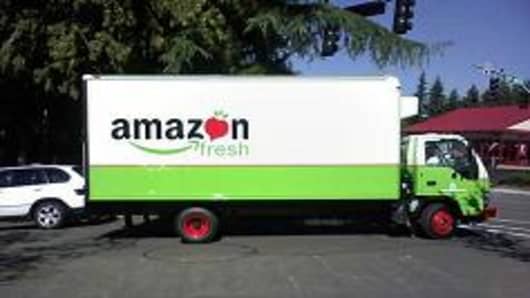As a percentage, it’s even a smaller piece of the total U.S. grocery bill. Last year, consumers spent $5.5 billion shopping for their groceries online, or less than 1% of U.S. grocery sales, Freeman said.
Still, sales are growing, and experts have found the business can help strengthen ties with existing customers.
Building Customer Ties
“The more ways you can touch consumers gives you more opportunities to increase the size of the purchase and the frequency of purchases,” said Kathryn Cullen, vice president of Kurt Salmon Associates. “It also allows companies to charge additional fees for the service that are not linked to the cost of the low-margin products being bought.”
Plus, Amazon is under constant pressure to keep increasing its revenue base, and has proven successful in expanding its franchise beyond books in past. Most recently, the company launched a toy business after its partnership with Toys R Us ended in the second quarter of last year. According to Goldman Sachs analyst Anthony Noto, Amazon has improved the selection of toys offered through its Website and it continues to show strong sales growth, despite the higher cost of operating its own business.
Entering the new business will present Amazon with a number of challenges such as the need to deal with perishable items. However, the online retailer is making its move cautiously, having taken a few lessons from the past experiences of other online grocers.
Rather than launch ambitiously to multiple cities as pioneer online grocer Webvan did, Amazon will roll the program out slowly. This strategy has proven helpful for companies such as Fresh Direct, which built up its franchise over time by gradually adding to its territory in the New York metropolitan area.
The new venture, Amazon Fresh, will begin as a pilot study with limited by-invitation service to residence in Mercer Island, Washington. Future online grocery pick-up locations are expected to be Bellevue and Kirkland.
“It's just starting out, and it's very small,” said Craig Berman, a spokesman at Amazon.com. “We are in the early-stage beta test.”
According to Berman, Amazon is responding to customers, who asked for grocery service after the company began selling gourmet foods through its site.
Keeping It Fresh
Still, in order to provide its customers with high-quality perishable items, Amazon will need to deliver the items directly to consumers in its own fleet of Amazon Fresh refrigerated truck instead of relying on third-party services such as UPS or the U.S. Postal Service.
Amazon declined to comment on its financial goals for Amazon Fresh, but several “bricks and motor” grocers have found it helpful to establish online grocery services, despite the cost of launching such ventures, as a way of further strengthening their customer relations. These have included Albertson’s, Kroger’s and Stop & Shop, which has partnered with Peapod.
“The key is to capitalize on loyal customers with reliable quality,” said Freeman, of Jupiter Research.
Those who do their grocery shopping online tend to live in metropolitan areas. According to statistics from Jupiter Research, 8% of female online shoppers purchase groceries online compared with 5% of male consumers. The younger working generation, who are familiar with the Internet, are more likely to grocery shop online.
Fresh Direct caters to this demographic by delivering to residences and offices in the New York City area.
According to Chief Executive Steve Michaelson, the idea is to focus on a heavily populated area and customers who don’t have the time to buy groceries. By remaining in a highly concentrated area, the company can promise delivery within a two-hour window, he said.
Fresh Direct made its first deliveries to Roosevelt Island in 2002. Since then, the company has expanded service to Manhattan, Brooklyn, Queens, the Bronx and parts of Nassau County, Westchester County and New Jersey. The company now has 1,800 employees, 250,000 customers, and has delivered more than 5 million orders.
One of Amazon’s biggest advantages will be its well-known website.




